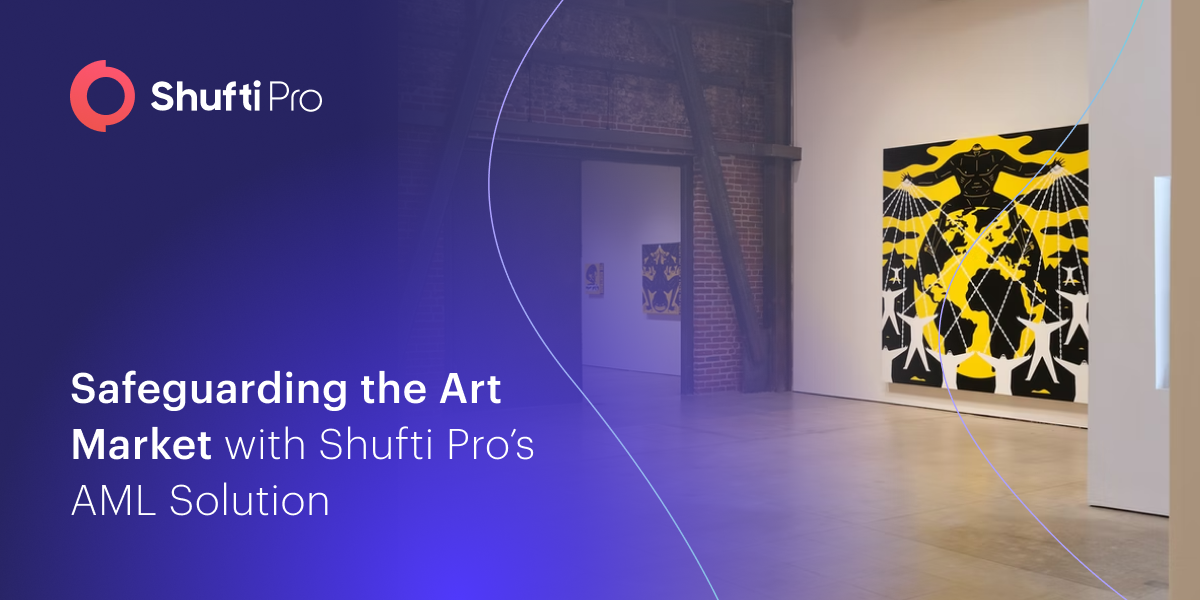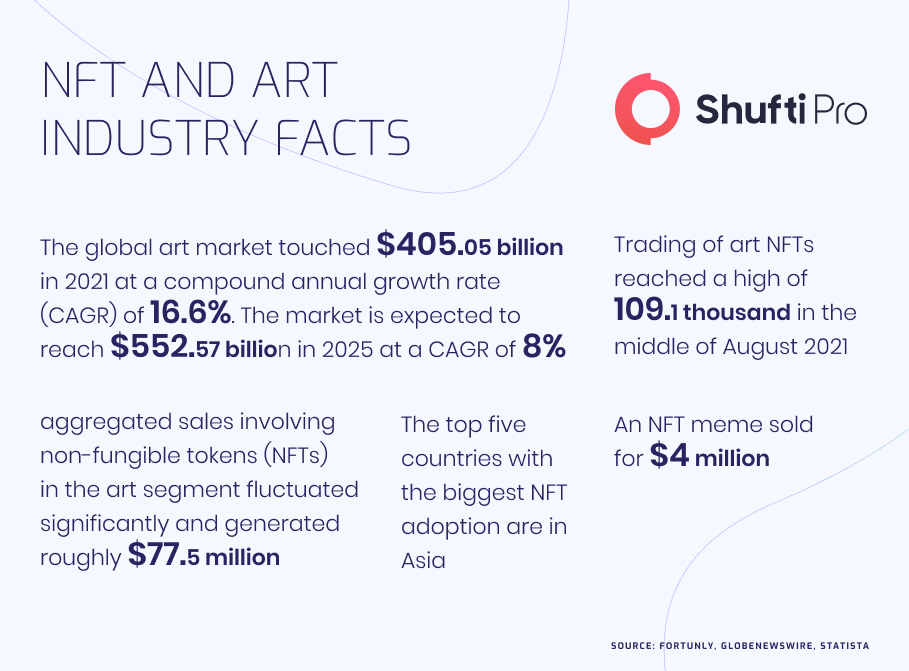Safeguarding the Art Market with Shufti’s AML Screening Solution

Non-fungible tokens (NFTs), blockchain-powered title deeds tied to a virtual or physical asset, have become an essential constituent of the art industry. With the advent of blockchain technology, businesses like the art industry are increasingly accepting payments made through cryptocurrencies. The decentralized nature of digital currencies and NFTs are making them attractive for a lot of reasons, but it is also creating challenges for legal oversight. For example, Beeple’s NFT art collection was sold for more than $69 million at an auction, and CryptoPunk NFT sold for $23 million.
In addition to this, NFTs are transforming the art industry as they are often used as digital tokenized representations of high-value art, but are highly vulnerable to money laundering activities. However, the risk of financial crimes presented by NFTs is not unique, they are simply another significant avenue that fraudsters attempt to exploit. However, as NFTs are powered by blockchain technology, they are publicly auditable, verifiable and digitally unique which provokes criminals to use them for illicit gains.
NFTs and The Art Market – The New Target for Criminals
Non-Fungible Tokens (NFTs) are among one the hottest topics trending at the moment. In March 2021, Mike Winkelmann, a famous artist known as Beeple, sold one of his art masterpieces as NFT at the auction house for USD 69 million. The sale made him one of the most valuable living artists. However, less than a year later, the leading NFT marketplace OpenSea kicked off the year with an NFT trading volume of more than $5 billion in January 2022. However, this number is equal to the volume of the whole generated in 2021. Ever since it’s just to say the non-fungible tokens are the future of art and here to stay.
On another hand, art has been used as a store of value for ages, and with that, the industry comes with a long history of money laundering and other financial crimes. Unlike other high-valued assets including gold or stocks, the worth of the artwork is subjective to the owner or viewer. However, famous paintings are often priced in the double-digit millions with the most popular artworks, like the Salvator Mundi by Leonardo da Vinci, being sold for nearly $450 million. Thus, artworks including paintings, sculptures, etc. are a perfect choice for storing, exchanging and moving large amounts of money in a most compact way. However, as the market is famous for high profits, yet has been prone to money laundering and various other crimes for decades.
In February 2022, the US Treasury Department’s Financial Crimes Enforcement Network (FinCEN) released a “Study of the Facilitation of Money Laundering and Terror Finance Through the Trade in Works of Art” in which the significant risk of money laundering through the art market was highlighted. As NFTs are one of the kinds of digital artworks and therefore inherit some of the distinctive traits of traditional art.
Moreover, NFTs emerged with the benefit of being fully digitized, making it easier to trade or move physical assets. Like with digital currencies, NFT can be transferred from one digital wallet to another in a matter of seconds. Whereas, the key factor that makes the non-fungible tokens attractive to money launderers or organized crime groups is their volatile prices. While the bitcoin or fiat currency exchanges follow the market principles of supply and demand, the value of NFTs is highly speculative. For instance, the NFT bought with 1 EUR can be sold out nor 1 million EUR the next day. This enables as well as provokes criminals to launder illicit earnings through a series of legit transactions. Moreover, to assist criminals blockchain technology allows to track transactions between wallets, without requiring to know your customer verification, making it quite easier to make anonymous transactions. Therefore, having these risks in mind, FinCEN states that “the emerging digital art market” presents a critical threat for money laundering as well as other financial crimes.

Global Regulatory Regime to Secure ART Industry
With little or no regulations along with major loopholes, the art industry is getting prone to criminal activities, while allowing fraudsters to make anonymous transactions. Thus, it gets hard to determine the source of money and if the criminals are using freeports to carry out such illicit activities, there is no chance of identifying the origin of money laundering. To secure the operations and overwatch the activities, global regulatory authorities across different jurisdictions have come up with laws and standards that must be followed by the art industry.
Let’s dive into the regulatory regime
EU AMLD
To regulate the European art industry the EU parliament has emerged with a series of anti-money laundering directives. To date, the sixth directive is in power that covers business entities along with individual entities involved in art trading, acting as intermediaries or storing artefacts in free zone ports. As per the directive’s guidelines, if the direct or linking transactions are equal to or more than EUR 10,000 need to be verified before it’s carried out. However, to secure industry integrity, 6AMLD mandates AML screening and customer due diligence procedures mandatory for all the entities linked to the art industry.
Responsible Art Market (RAM)
This law was legislated in Geneva back in 2015. This aim is to reduce the risk of money laundering and terrorist financing via the art market. This is responsible for governing the art industry, including auction houses, galleries and other businesses linked with art dealings. According to this, the entities need to comply with know your customer compliance, which will help them to authenticate the true identity of customers before getting them on board. Additionally, businesses need to develop transaction monitoring systems to create risk profiles.
Her Majesty’s Revenue and Customs (HMRC)
The artwork businesses, dealers, auction houses and every single individual linked with art trading is subject to UK’s AML regulations. On June 28, HMRC published the first risk assessment of art markets and made it mandatory for such businesses to develop risk assessment protocols to determine the threat of money laundering. The regulatory authority is also obliged to share the updated data records regarding money launderers including the information collected by the risk assessment system set up by art businesses. On another hand, the businesses linked with art dealings need to follow the Treasury-approved British Art Market federation Guidance and the other relevant documents, including the National Risk Assessment 202 and FATF guidance regarding money laundering.
What Shufti Offers
Shufti’s robust AML Screening solution allows businesses dealing with art trading to identify investors and ensure that dirty money is not used for transactions. Furthermore, powered with thousands of AI models, AML background screening as well as ongoing transaction monitoring allows businesses to keep a check on every transaction, making risk profiles and authenticating clients against 1700+ financial crime watchlists in less than a second with 98.67% accuracy.
Want to learn more about AML Screening for the Art Industry?











